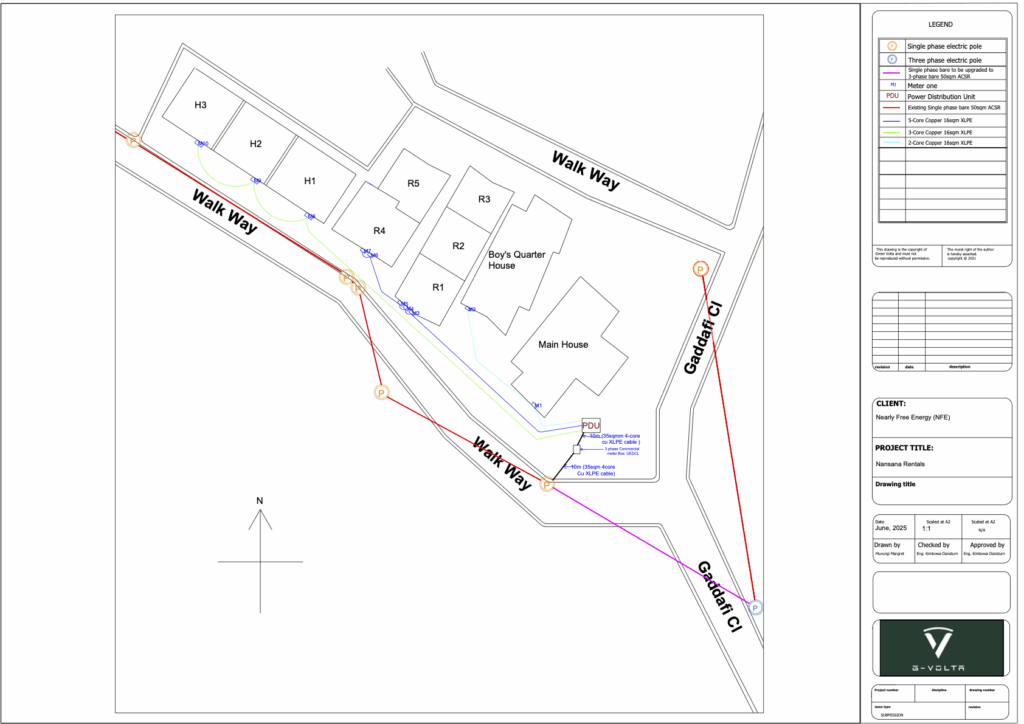“Even a journey of 1000 miles begins with a single step”
~ Ancient Chinese Proverb
Location
In September 2025, we deployed our first microgrid to a small community of 10 customers in a small densely populated town called Nansana, right outside the Ugandan capital of Kampala.

The goal
To demonstrate that a grid connected microgrid can provide a sustainable way for a community to provide power at a lower cost through bulk billing and allow the community to monitor their energy usage for solar and battery backup sizing.
The problem
We have 10 residential energy consumers connected to the main grid. They consume about 1 to 3 kWh a day each which costs them about 80,000 UGX per month for each household. However they get 6 to 12 hours of unscheduled and indeterminant power outages every week for all the reasons shared here.
From what they shared, the closest transformer they are connected to may be overloaded causing phase to phase voltage to significantly drop occasionally but we didn’t have the data to verify this before deployment.
The technical details
We deployed extended a 3 phase main grid connection and reconnected the homes to the grid via this connection. The connection to the grid is metered with a large commercial 3 phase meter controlled by UEDCL. The connection is sized to deliver 415V, 100A (240V phase to phase) for up to 30 kWh load. That meter is mirrored by another 3 phase meter we control.

Single phase connections to each household are metered by smart meters connected to an AMI provided by the meter supplier.
Tech Stack
Metering: Din rail Calin Smart Meter with inbuilt relays and LoraWAN modules
Connectivity: Central LoraWAN gatway that is 4G enabled with SIM card.
AMI: CalinAMI for hourly meter readings and remote on/off.
Communication: Whatsapp for customer support and a Microgrid Manager who resides in the community.
Billing: Monthly postpaid payments via Pesapal (Mobile Money, Visa/Mastercard). Invoicing managed via EFRIS.
Finances: We are tracking our spending and inflows (contributions and income) via Open Collective here.
Documentation: Most information about this microgrid is available on our public Wiki here.
Present Challenges
Metering: We are seeing anomalous behavior with the smart meter connections getting dropped. It maybe coming from clustering LoraWAN enabled meters in a meter box but we don’t know at this point. We do get enough connectivity to collect and view high fidelity data on daily usage patterns on most days.
Next Release: Phase 2 goals
Backup: The primary goal is to deploy batteries and or solar capacity to handle at least 6 hours of a power outage during peak demand windows (6pm to 12 midnight).
Metering 2.0: Secondarily we’d like to move to an Open Source AMI we can modify ourselves instead of the proprietary one we currently use. And since our meters are clustered, we’d like to connect to them directly via RS485/Modbus to a raspberry-pi running OpenEMS edge. We think hard wiring to the meters locally will be a more stable solution than the wireless connectivity via LoraWAN.
CRM: We would like to switch to MicroPowerManager for our CRM. We need to add invoicing and postpaid capabilities to it and integrate it with EFRIS which we must continue using for easier tax compliance.
For more on this project, you can connect with the NFE team via our public channel on Matrix or receive our quarterly progress updates via our community mailing list.
You can also make contributions to the project to support phase 2 via Open Collective here.

